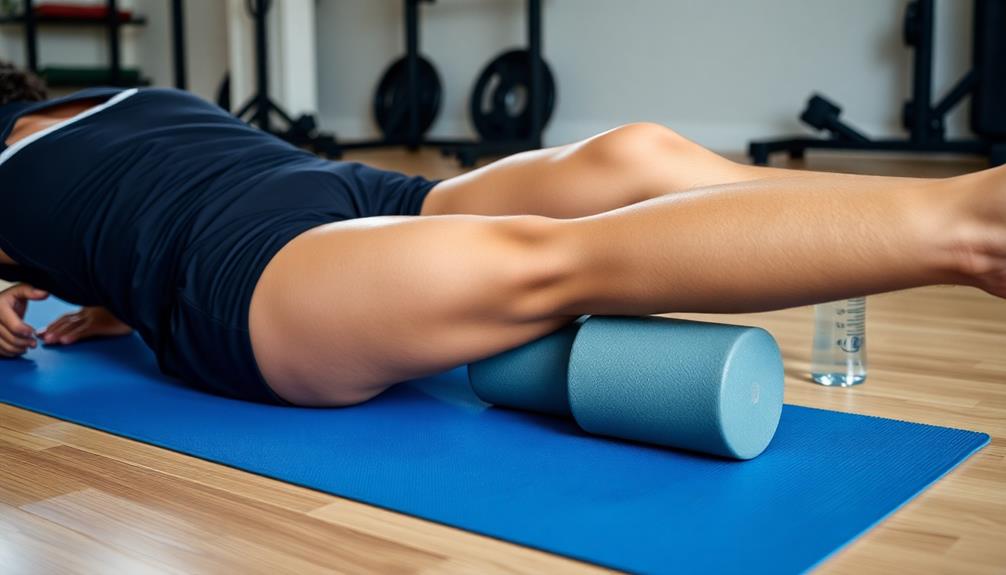To optimize your post-resistance training recovery, follow these five essential tips. First, engage in light cardio sessions to boost blood flow and promote muscle recovery. Next, incorporate dynamic stretching routines to improve flexibility and reduce soreness. Practice foam rolling techniques to break up muscle knots and increase flexibility. Consider low-impact sports like swimming or cycling to maintain cardiovascular fitness without straining muscles. Finally, prioritize proper nutrition and hydration by consuming a balanced mix of protein, carbs, and healthy fats, along with adequate fluids. By implementing these strategies, you'll enhance your recovery process and maximize your fitness gains. Discover more in-depth insights on each tip to further refine your active recovery routine.
Core Insight
- Engage in light cardio sessions like jogging or biking to boost blood flow and aid muscle recovery.
- Incorporate dynamic stretching routines to improve flexibility and reduce muscle soreness after strength training.
- Practice foam rolling techniques to break up muscle knots, increase flexibility, and alleviate post-workout soreness.
- Participate in low-impact sports like swimming or yoga to maintain cardiovascular fitness without straining muscles.
- Prioritize proper nutrition and hydration, including protein and carbs, to support muscle recovery and replenish energy stores.
Embrace Light Cardio Sessions

Gentle activities like jogging or biking are perfect for recovery after tough workouts. They boost blood flow to your muscles, reducing soreness and helping you heal faster. Aim for 15-30 minutes at a low intensity, keeping your heart rate around 120-140 beats per minute. Electrolyte gummies can help you stay hydrated and replace minerals lost through sweat.
Pick activities you enjoy that don't strain your muscles too much. Swimming, using an elliptical, or walking briskly are all great choices. The goal is to help your body recover, not to burn calories or get a cardio workout.
During these sessions, focus on good form and breathing. Pay attention to your body and adjust if needed. You should feel refreshed and energized after, not tired. Add these light cardio sessions to your routine 1-2 days after hard resistance training for the best results.
Incorporate Dynamic Stretching Routines

Dynamic stretches are a great addition to your active recovery days. They help improve flexibility and reduce muscle soreness after strength training. Try adding dynamic stretches that work the main muscle groups you used during your workout.
Here's a simple dynamic stretching routine to try:
| Exercise | Repetitions | Target Area |
|---|---|---|
| Arm circles | 10 each way | Shoulders |
| Leg swings | 10 each leg | Hips, hamstrings |
| Torso twists | 10 each side | Core, back |
| Walking lunges | 10 each leg | Quads, glutes |
| High knees | 20 total | Legs, core |
Do each exercise for the given number of reps. Move smoothly through the routine and remember to breathe deeply. Keep good form as you go. This stretching sequence will get your body ready for your next workout and help you recover from your last one.
Practice Foam Rolling Techniques

Foam rolling is a great way to help your muscles recover after a workout. It breaks up knots and tightness, making you more flexible and less sore. Start by picking a foam roller that feels comfortable for you. You can also use cooling towels to reduce swelling and help your muscles heal faster.
Begin with big muscles like your back, butt, and thighs. Roll slowly, stopping on sore spots for 20-30 seconds. Press firmly, but not so hard that it really hurts. As you get used to it, you can press harder.
Next, do smaller muscles like calves and arms. Use the same method, changing the pressure as needed. Take deep breaths the whole time. Spend 5-10 minutes foam rolling after your workout, focusing on the muscles you used. If you do this regularly, you'll recover better and become more flexible.
Engage in Low-Impact Sports

Engage in low-impact sports like swimming, cycling, or yoga to stay active while giving your muscles a chance to recover after resistance training. These activities are good for your heart and lungs without being too hard on your body. Swimming uses your whole body, and the water helps support your weight. Cycling gets your blood pumping and improves flexibility. Yoga combines stretching and strength-building while helping you relax and be aware of your body.
Pick a low-impact sport that works well with your resistance training. Aim for 20-30 minutes at a light to medium intensity. Pay attention to how your body feels and change the intensity if needed, so you don't overdo it while recovering.
Prioritize Proper Nutrition and Hydration

Eating right and drinking enough water are just as important as exercise when you're recovering. Your body needs the proper nutrients and fluids to help your muscles heal and get stronger. Aim for a mix of protein, carbs, and healthy fats in your diet. And don't forget to drink water all day long to stay hydrated.
After a workout, follow this simple nutrition plan:
- Eat protein within 30 minutes to repair muscles. Try chicken or eggs.
- Have carbs within 2 hours to refill your energy. Good options are oats or sweet potatoes.
- Keep drinking water for fluid balance. Coconut water works too.
- Replace minerals lost in sweat with electrolytes from sports drinks or bananas.
Frequently Asked Questions
How Long Should I Wait Before Starting Active Recovery After Resistance Training?
You can start active recovery immediately after resistance training. It's best to begin with light movements or stretches right after your workout. Don't wait too long, as active recovery helps reduce muscle soreness and promote faster healing.
Can I Perform Active Recovery on Rest Days Between Workouts?
Yes, you can perform active recovery on rest days between workouts. It's actually a great way to promote blood flow, reduce muscle soreness, and maintain flexibility. Just keep the intensity low and focus on gentle movements and stretches.
Are There Any Specific Active Recovery Exercises for Different Muscle Groups?
You can target specific muscle groups during active recovery. Try light jogging for legs, swimming for full-body, yoga for core and flexibility, or gentle resistance band exercises for arms and shoulders. Tailor activities to your workout routine.
Should I Adjust My Active Recovery Routine Based on Workout Intensity?
Yes, you should adjust your active recovery routine based on workout intensity. After intense sessions, focus on gentle movements and stretches. For moderate workouts, you can incorporate light cardio or yoga. Always listen to your body's needs.
How Can I Monitor Progress and Effectiveness of My Active Recovery Practices?
You can monitor your active recovery's effectiveness by tracking soreness levels, energy during workouts, and overall performance. Keep a journal, use fitness apps, and listen to your body. Adjust your routine based on these observations for best results.

